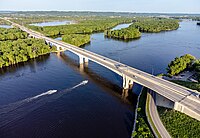
Photo from wikipedia
Abstract European design standards have established an upper limit on the deck acceleration of the high-speed railway bridges, however the influence of local vibrations of the deck members is rarely… Click to show full abstract
Abstract European design standards have established an upper limit on the deck acceleration of the high-speed railway bridges, however the influence of local vibrations of the deck members is rarely considered when modelling the vibrational responses of bridges. To evaluate how the inclusion of local deck vibrations might influence predictions of the maximum acceleration, detailed measurements were taken from a steel-concrete composite box-girder bridge on the Italian high-speed railway, and a numerical model of the system was developed. Deck vibrations were measured during high-speed train passages at the maximum train speed of 374 km/h, and compared against a numerical model of the vehicle-bridge system. This analysis revealed that the maximum deck acceleration is 1.3 times greater than the acceleration of the bridge girders, because of the sixth- and seventh-order resonance between the deck’s local vibration modes and the structure with a train running at high speeds over 300 km/h. Moreover, when considering local deck vibrations in the numerical model, we found that the interaction between transient local rail deformations and the vehicle travelling on the rails can increase the acceleration of the deck through resonance.
Journal Title: Engineering Structures
Year Published: 2019
Link to full text (if available)
Share on Social Media: Sign Up to like & get
recommendations!